 |
Convert OGV to Xvid
|
OGV to Xvid Converter Software converts OGV files to Xvid
fast. Xvid offers outstanding quality and performance clearly surpassing expensive,
competing products. Xvid allows you to create video for interoperable exchange
with portable or home multimedia devices as Xvid is widely supported in hardware.
Being open-source, Xvid is future-proof and secure to use.
Besides OGV and Xvid, the converter also supports common and uncommon video
and audio formats and protable devices such as VCD, Android Phone, TIFF image sequence, 3G2, AIFF, MP2, OGM, etc. It could convert
MOD to DivX, AVI to CAF (Core Audio Format), FLV to VCD, M2TS to PPM image sequence, WebM to OGM, and so on.
OGV to Xvid Converter Software supports batch conversion and, is
full compatible with 32-bit and 64-bit editions of Windows 10/8/7/Vista/XP/2000.

What is OGV?
The OGV file format is the container format for the Theora video compression
format, and the Vorbis audio format. It is an open source container format
supported by many open source video players. Like all our multimedia technology
it can be used to distribute film and video online and on disc without
the licensing and royalty fees or vendor lock-in associated with other
formats. Theora is an open and royalty-free lossy video compression technology
being developed by the Xiph.Org Foundation as part of their Ogg project.
Based upon On2 Technologies' VP3 codec, Theora competes with MPEG-4, WMV,
and similar low-bitrate video compression schemes. A May 2009 review of
this work shows a considerable improvement in quality, both subjectively
and as measured by PSNR, just by improving the forward DCT and quantisation
matrices. Further work on adaptive quantization, as well as overall detailed
subjective tuning of the codec, is still to come. Theora scales from postage
stamp to HD resolution, and is considered particularly competitive at low
bitrates. It is in the same class as MPEG-4/DiVX, and like the Vorbis audio
codec it has lots of room for improvement as encoder technology develops.
Theora is a free and open video compression format from the Xiph.org Foundation.
Theora supports intra-coded frames and forward-predictive frames, but not
bi-predictive frames which are found in H.264 and VC-1. However there are
currently no Theora decoder chips in production, and portable media players,
smartphones and similar devices with limited computing power rely on such
chips to provide efficient playback. Theora video streams can be stored
in any suitable container format. Most commonly it is found in the Ogg
container with Vorbis or FLAC audio streams which provides a completely
open, royalty-free multimedia format. It can also be used with the Matroska
container.
What is Xvid?
XviD is the name of a popular new video codec being developed as an open
source project by volunteer programmers from all over the world. In early
2001, DARC member Sparky wrote an improved version of the encoding core
called encore2. This was updated several times before, in April, it was
removed from CVS without warning. The explanation given by Sparky was "We
(our bosses) decided that we are not ready to have it in public yet."
An open source MPEG-4 video codec. XviD was created to offer a free alternative
to other commercial video codecs. Xvid encoded files can be written to
a CD or DVD and played in some (not all) DivX compatible DVD players and
media players. However, Xvid can optionally encode video with advanced
MPEG-4 features that most DivX Certified set-top players do not support.
After articles were published in Slashdot and The Inquirer, in August 2002
Sigma Designs agreed to publish their source code. XviD-compressed videos
can be 200 times smaller than the source video, with the visual quality
well intact. Hence, Xvid can somewhat be seen as a ZIP for video. But unlike
ZIP, Xvid is not lossless. That means that a video after compression and
decompression with Xvid won't be identical to the original source. Typically
however, a difference to the source is visually imperceptible. When Sigma
Designs released the supposedly rewritten REALmagic codec, the Xvid developers
immediately disassembled it and concluded that it still contained Xvid
code, only rearranged in an attempt to disguise its presence. To give an
example: uncompressed digital video is huge and requires about 100 GB per
hour at PAL resolution. The same video would require just 500 MB per hour
at very high quality when compressed with Xvid. That is a compression ratio
of 200:1.
How to Convert OGV to Xvid?
- Free Download OGV to Xvid Conversion
Software
- Install the Program by Step-by-step Instructions
- Launch OGV to Xvid Converter Software
- Choose OGV Files
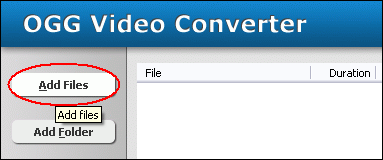
Click "Add Files" to choose OGV files.

Choose one or more OGV files you want to convert and then click Open.
OGV to Xvid Converter Software will open OGV files and get file
information of the file such as width, height, frame rate, video bit rate, audio
sample rate, audio bit rate, audio channels, and then display the information
of OGV file at conversion list.
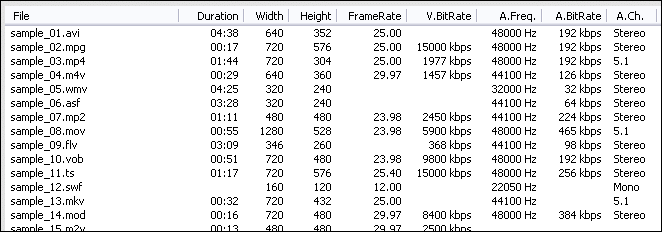
- Choose Output Format
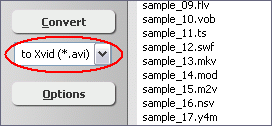
Click on combo box of output format and then choose "to Xvid".
- [Optional, for advanced user]
Set Xvid Encoding Parameters
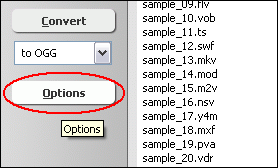
If you want to change Xvid encoding parameters such as bit rate, frame rate, video
size, and aspect ratio, please click "Options".

And then, switch to tab "Video & Audio" and choose "Xvid
(*.avi)" at "Output Format", and then set options for
video and audio.
- Convert OGV to Xvid
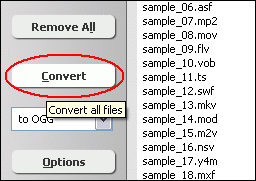
Click "Convert" to convert all OGV files in list to Xvid format.

The software is converting OGV files to Xvid.
- Play and Browse Xvid File
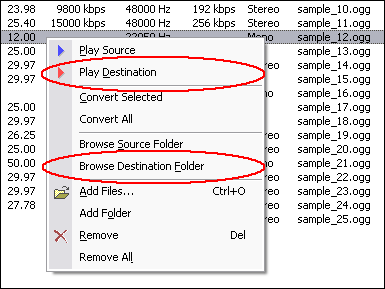
When conversion completes, you can right-click converted item and choose "Play
Destination" to play the outputted Xvid file; or choose "Browse
Destination Folder" to open Windows Explorer to browse the outputted Xvid
file.
- Done
Top
OGV to Xvid Converter Software is 100% clean and safe to
install. It's certified by major download sites.

Convert OGV to Xvid Related Topics:
|











